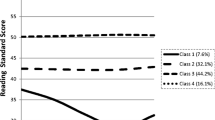Abstract
Sixty-two children were evaluated 4 years after their initial referral for symptoms of hyperactivity. Behavioral measures included parent and teacher judgments of behavior and social adjustment. Academic achievement was assessed by teachers' reports, number of failed grades, special education services, and two individually administered achievement tests. Data were analyzed for the total group to determine both the extent to which presenting problems diminished over time and the major problems still present. The effects of stimulant drug therapy on outcome were assessed by dividing the children into groups according to the duration of time they had taken stimulants. Total duration of time on stimulants ranged from less than 6 months (group 1) to 4 years (group 5). Results indicated that the symptoms of hyperactivity significantly lessened, but remained higher in these children than in normal peers. Behavioral and social problems were less pervasive than academic underachievement. There were no group differences, indicating that the duration of stimulant intervention did not have a significant effect on outcome. The clinical implication of this study is that the beneficial effects of stimulant drug intervention occur within the first months after initiation of therapy. Long-term treatment does not appear to be of value in producing better outcome.
Similar content being viewed by others
References
Akerman, P. T., Dykman, R. A., & Peters, J. E. Teenage status of hyperactive and nonhyperactive learning disabled boys.American Journal of Orthopsychiatry, 1977,47, 577–596.
Barkley, R. A. Recent developments in research on hyperactive children.Journal of Pediatric Psychology, 1978,3, 158–163.
Blounin, A. G., Bornstein, R. A., & Trites, R. L. Teenage alcohol use among hyperactive children: A five year follow-up study.Journal of Pediatrie Psychology, 1978,3, 188–194.
Borland, B. L., & Heckman, H. K. Hyperactive boys and their brothers.Archives of General Psychiatry, 1976,33, 669–675.
Bradley, C. Characteristics and management of children with behavior problems associated with organic brain damage.Pediatric Clinics of North America, 1957,4, 1049–1060.
Charles, L., Schain, R. & Guthrie, D. Long-term use and discontinuation of methylphenidate with hyperactive children.Developmental Medicine and Child Neurology, 1979,21, 758–764.
Charles, L., Schain, R., & Guthrie, D. A study of prolonged administration of methylphenidate in childhood hyperactivity. In W. M. Cruickshank (Ed.),Approaches to learning (Vol. 1):The best of ACLD. Syracuse: Syracuse University Press, 1980.
Charles, L., Schain, R., Zelniker, T., & Guthrie, D. Effects of methylphenidate on hyperactive children's ability to sustain attention.Pedriatrics, 1979,64, 412–418.
Hoy, E., Weiss, G., Minde, K., & Cohen, N. The hyperactive child at adolescence: Cognitive, emotional, and social functioning.Journal of Abnormal Child Psychology, 1978,6, 311–324.
Huessey, H. R., & Cohen, A. H. Hyperkinetic behaviors and learning disabilities followed over seven years.Pediatrics, 1976,57, 4–10.
Laufer, M. W., & Denhoff, E. Hyperkinetic behavior syndrome in children.Journal of Pediatrics, 1957,50, 463–474.
Loney, J., Langhorne, J. E., Jr., Paternite, C. E., Whaley-Klahn, M. A., Blair-Broeker, C. T., & Hacker, M. The Iowa habit: Hyperkinetic/aggressive boys in treatment. In S. B. Sells (Ed.),Human functioning in longitudinal perpectives: Studies of normal and psychopathic populations. Baltimore: Williams and Wilkins, 1980.
Mendelson, W., Johnson, N., & Stewart, M. A. Hyperactive children as teenagers: A followup study.Journal of Nervous and Mental Disease, 1971,153, 273–279.
Menkes, M. M., Rowe, J. S., & Menkes, J. H. A twenty-five year follow-up study of the hyperkinetic child with minimal brain dysfunction.Pediatrics, 1967,39, 393–399.
Milich, R., & Loney, J. The role of hyperactive and aggressive symptomatology in predicting adolescent outcome among hyperactive children.Journal of Pediatric Psychology, 1979,4, 93–112.
Minde, K., Weiss, G., & Mendelson, N. A 5-year follow-up study of 91 hyperactive school children.Journalof the American Academy of Child Psychiatry, 1972,11, 595–610.
Riddle, K. D., & Rapoport, J. L. A 2-year follow-up of 72 hyperactive boys: Classroom behavior and peer acceptance.Journal of Nervous and Mental Disease, 1976,162, 126–134.
Safer, D. J., & Allen, R. P. Stimulant drug treatment of hyperactive adolescents.Diseases of the Nervous System, 1975,36, 454–457.
Schain, R. J., & Reynard, C. L. Observations on effects of a central stimulant drug (methylphenidate) in children with hyperactive behavior.Pediatrics, 1975,55, 709–716.
Stewart, M. A., Mendelson, W. B., & Johnson, N. E. Hyperactive children as adolescents: How they describe themselves.Child Psychiatry and Human Development, 1973,4, 3–11.
Weiss, G., Hechtman, L., & Perlman, T. Hyperactives as young adults: School, employer, and self-rating scales obtained during a ten-year follow-up evaluation.American Journal of Orthopsychiatry, 1978,48, 438–445.
Weiss, G., Hechtman, L., Perlman, T., Hopkins, J., & Wener, A. Hyperactives as young adults.Archives of General Psychiatry, 1979,36, 675–682.
Weiss, G., Kruger, E., Danielson, U., & Elman, M. Effects of long-term treatment of hyperactive children with methylphenidate.Canadian Medical Association Journal, 1975,112, 159–165.
Weiss, G., Minde, K., Werry, J. S., Douglas, V. I., & Nemeth, E. Studies on the hyperactive child.Archives of General Psychiatry, 1971,24, 409–414.
Werry, J. S., Sprague, R. L., & Cohen, M. N. Conners' Teacher Rating Scale for use in drug studies with children—An empirical study.Journal of Abnormal Child Psychology, 1975,3, 217–229.
Author information
Authors and Affiliations
Rights and permissions
About this article
Cite this article
Charles, L., Schain, R. A four-year follow-up study of the effects of methylphenidate on the behavior and academic achievement of hyperactive children. J Abnorm Child Psychol 9, 495–505 (1981). https://doi.org/10.1007/BF00917798
Revised:
Issue Date:
DOI: https://doi.org/10.1007/BF00917798




